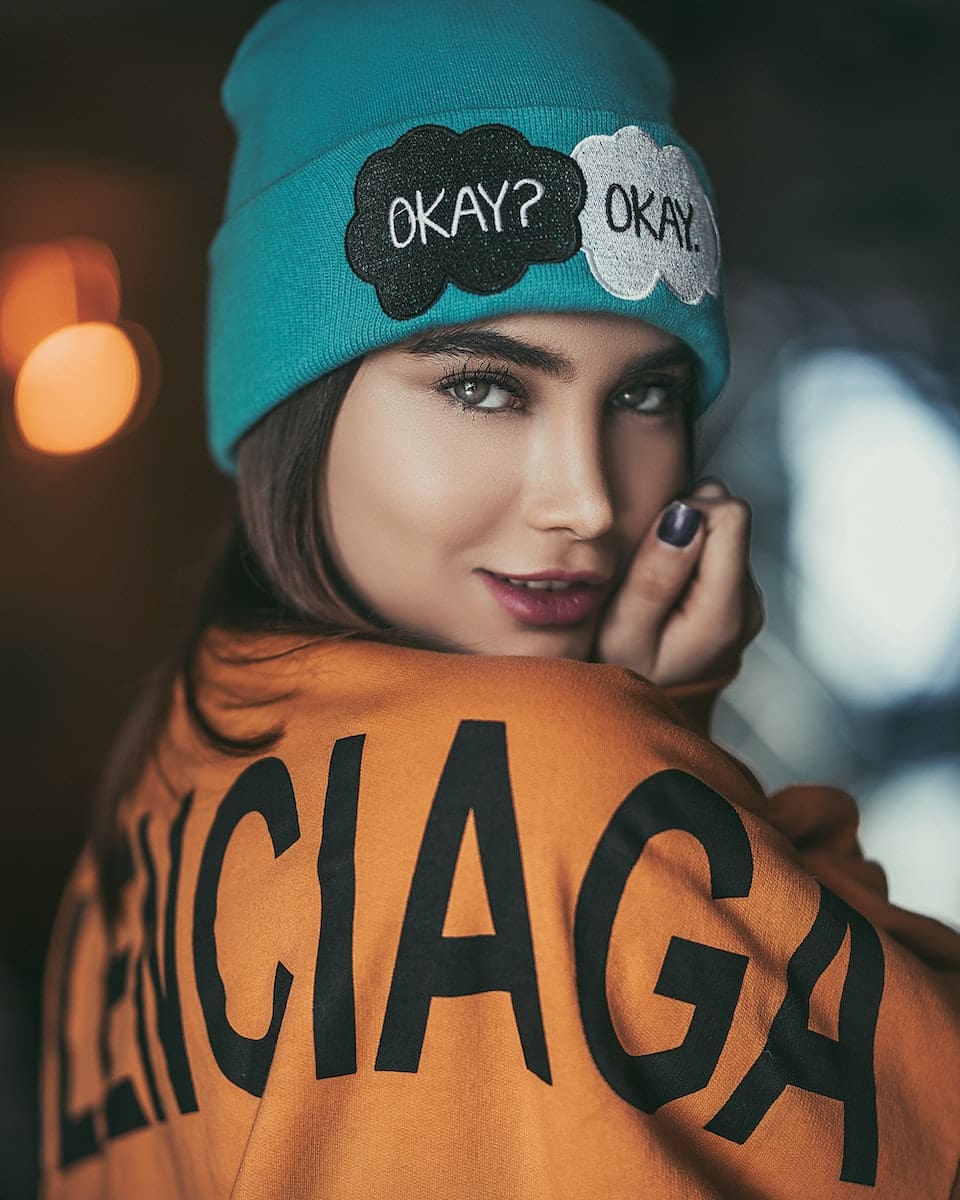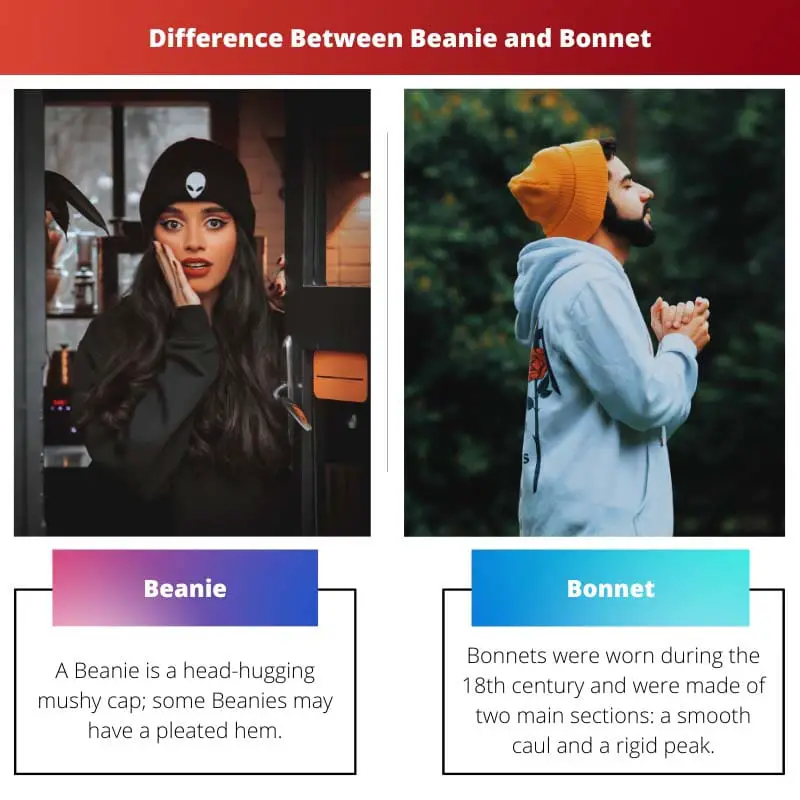We all have clothes and garments according to our needs and style, for different parts of our body we have different clothing.
For example to cover our body we have different clothes such as pants, shirts, salwar, saree, etc. for our hands we have hand gloves; similarly to cover and style our head we have a cap, hats, etc.
Hats and caps prevent sunburn on our head and face area and shield our eyes from the sun’s glare. It saves us from the cold breeze in the winter that might harm our forehead, cheeks, and ears lobes.
There are various varieties of caps and hats available in the market Beanie and Bonnet are among the two hats design that we are going to discuss in this article.
Key Takeaways
- Beanies are close-fitting, knitted or woven caps, while bonnets are soft, brimless hats with a ribbon or strap to secure them under the chin.
- Beanies are popular for casual wear and cold weather, whereas bonnets are associated with historical or formal attire.
- Beanies are unisex and come in various materials and styles, while bonnets are more commonly worn by women and infants.
Beanie vs Bonnet
The difference between Beanie and Bonnet is that Beanie is a tight-fitting cap with woolen fibers, while a Bonnet is a form of headgear used by women and kids in the past and fastened by ribbons knotted underneath the jaw bone. Beanies were fashionable in the 1990s and much more lately in the 2000s. Bonnets, on the other hand, were popular all through the nineteenth century.

A Beanie is a head-hugging mushy cap; some Beanies may have a pleated hem. They can be basic or embellished with hooks, tassels, polka, and other decorations.
Beanies are known by a variety of names due to the variety of styles available such as; skull caps, knit caps, tossie, ski caps, etc.
Bonnets were worn during the 18th century and were made of two main sections: a smooth caul and a rigid peak whose front is wider than its back and which gradually narrowed to none at all at its back.
Even though Bonnet sizes and designs differed, the most ordinary style had an average size, descending sloping brim.
As time passes Bonnets were redesigned, strings were sometimes excluded from the design, creating skepticism about whether they were Bonnets or simply hats.
Comparison Table
| Parameters of Comparison | Beanie | Bonnet |
|---|---|---|
| Existed since | 12th Century | 18th century |
| Wore by | It is unisex and worn by teens and college students | Women and children |
| Fabric | Acrylic – synthetic fiber | Silk or satin |
| Purpose | Cold-weather headgear that keeps the head warm | Keep dirt out of your hair and the sun out of your skin. |
| Country of Origin | Wales | Scotland |
What is a Beanie?
The purpose of Beanie-style caps in the past was simple: to ensure that the head stays cozy in the winter season. Hats in this form have been found in many places with a chilly environment over history due to their crucial purpose.
The origin of the Beanie cap’s name is indeed a mystery. The Beanie cap is thought to have been named following the head, which was called “bean” in the 1900s.
On the other hand, some claim that the term “Beanie” comes from the top button of the cap, which was nearly the size of a bean, that held the gathered cloth altogether.
Beanie caps come in a variety of fits, ranging from droopy and free on top to snug around the head area during winter, apart from this there are other benefits of Beanie caps, which includes:
– When it’s freezing outside, the insulated pom Beanies Keeps your head warm.
– Beanie cap can help protect us from harmful UV rays, something you don’t worry about as long as it’s chilly outside.
– For men and women who love to explore nature and are nature enthusiasts equally, a trendy Beanie is the ideal touch to winter clothes which gives them a stylish look.
Beanies have evolved into a mainstay for almost any fashion style, winter weather attire, and a means to express your personality with a variety of colors, designs, and your favorite team symbols.
Beanies are an excellent daily alternative for persons with hair loss due to chemo, baldness, aging, and other factors; they’re soft in the head, give warmth, and have a wonderful casual style.
Beanies are also frequently worn in the workplace it is worn by factory employees, those who operate with heavy machinery, and people who work in the food sector to keep their hair out of their faces in a pleasant fashion.
Beanies with a slouchy fit are extremely admired for this reason.

| # | Preview | Product | |
|---|---|---|---|
| 1 |

| Carhartt Men's Knit Cuffed Beanie, Black, One Size | Check Price on Amazon |
| 2 |

| NPJY Unisex Beanie for Men and Women Knit Hat Winter Beanies Black | Check Price on Amazon |
What is a Bonnet?
Bonnets is part of our culture for a very long time. Several types and kinds of Bonnets have been designed and used throughout the past for various purposes and situations.
The Bonnet first appeared in the Middle Ages, and it was largely worn by females and kids at that time. A coif was a cap composed of lightweight fabric looped all over the head having two strings underneath the chin worn by women and kids.
The majority of people wore it for self-effacement. Men wore woolen Bonnets that were sturdy and multi-purpose.
Bonnets are cloth headwear that does not have a brim, made of smooth and silky cloth that drapes around the head, enclosing the face but not covering the temple area of the head.
Apart from these features Bonnet also offers some special benefits such as:
– Bonnets for babies are stitched of soft fabrics such as silk or cotton and are worn at nighttime to offer warmth and comfort and to shield a baby’s fragile skin from the harmful rays of the sun.
– Females with innate curl or coiled locks sleep with silky Bonnet to protect their hair and maintain the style of their hair.
– It aids in the hydration of the hair, hair Bonnets keep your hair nourished and prevent your conditioning treatments from being absorbed by your pillow cover.
Bonnets were not designed to be fashionable, rather, they were worn to prevent or cover the hair from dirt and the sun when they were outside. However, the design and form of Bonnets have varied dramatically throughout history.
Bonnets evolved from practical lower-class caps to flowery headpieces which are used for their basic purposes.
Bonnets were also utilized for social or cultural reasons, most commonly to show respect, particularly among females. Today, Bonnets are primarily worn by infants as protection and warm headwear.
Bonnets are sometimes known as “sleeping caps” as many women especially African-American females use a satin or silk Bonnet to cover their hair while sleeping, to preserve their hair from breaking and tangling while sleeping.

Main Differences Beanie and Bonnet
1. Beanies are worn in winter to protect us from cold, whereas Bonnet is worn by babies and women for warmth and protection of hair from frizz and breakage.
2. Beanie is classified as cap whereas, Bonnet is classified as a hat.
3. In the olden day’s Beanie does not have a string attached to it whereas, a Bonnet comes with strings attached to it.
4. Beanie is more preferable by people as compared to Bonnet.
5. People use to wear Beanie in different styles and fashions to look stylish, whereas Bonnet is not meant for style.

- https://direct.mit.edu/jocn/article-abstract/23/6/1419/5117
- https://link.springer.com/article/10.1186/s12887-020-1917-5


